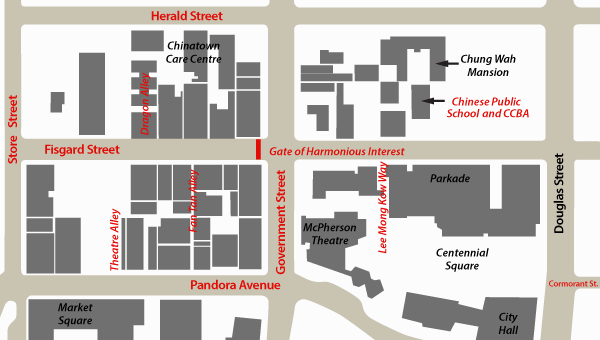- Home
- History
- Community
- Organizations
- Chinese Consolidated Benevolent Association
- Victoria Chinese Canadian Veterans Association
- Chinese Public School
- Clan Associations
- County Assocations
- Dialect Assocations
- Friendship Associations
- Political Organizations
- Recreational Associations
- Religious Organizations
- Women's Associations
- Other Organizations
- People
- Resources
- Contact
Streets in Transition
Click on items in red to go to the page for that item.

Victoria’s Chinatown, which is now located along the two blocks of Fisgard Street between Douglas and Store streets, grew out of a settlement of Chinese newcomers one block south. In the late 1850s, Chinese men from San Francisco were part of the wave of miners accessing the gold fields of the Fraser River via Victoria. Chinese merchants and western landowners built wooden huts to house Chinese workers along Cormorant Street (now known as Pandora Avenue). The Johnson Street Ravine, south of Cormorant Street, divided the small Chinatown to the north from Victoria’s city centre. When Victoria gained city status in 1862, about 300 residents, or six percent of the urban population, were of Chinese origin.
Chinatown grew again in the 1880s to four city blocks when sixteen thousand Chinese men travelled through Victoria en route to work on the Canadian Pacific Railway. Many wooden buildings were replaced by multi-storey brick buildings, owned by Chinese or western landlords, designed by western architects and sometimes incorporating Chinese design features. A number of opium factories operated in this neighbourhood, usually behind the street front buildings, until 1908 when the practice became illegal. By the 1910s, Victoria’s Chinatown was a bustling centre with almost 3,000 inhabitants and a variety of different land uses coexisting in about six city blocks, including housing, stores, schools, temples, theatres, and headquarters of clan and county associations. With just over 200 women living in Chinatown in 1911, this was a mostly male society.
After 1911, the population of Victoria’s Chinatown started to decline, as newcomers headed instead to Vancouver’s growing Chinatown, and the Immigration Act of 1923 halted further immigration from China until it was repealed in 1947. During the economic slump after the First World War and into the Depression, several Chinese and western property owners in Chinatown defaulted on their mortgages, and their properties reverted to the City. Market values were low in the 1940s and Chinese residents had a chance to buy these properties back from the City and western owners. By 1971, Victoria’s Chinatown was in severe decline, with a population of just 173. Some buildings were not properly maintained and they were condemned or demolished. However, in the late 1970s the Victoria City Council recognized the heritage and tourism potential of Chinatown, and with the involvement of historical geographer Dr. David Chuenyan Lai, started a revitalization program, resulting in street beautification, the construction of a Chinatown Care Facility and subsidized housing (the Chung Wah Mansion), renovating Fan Tan Alley to create artists’ studies, and commissioning the Gate of Harmonious Interest.

